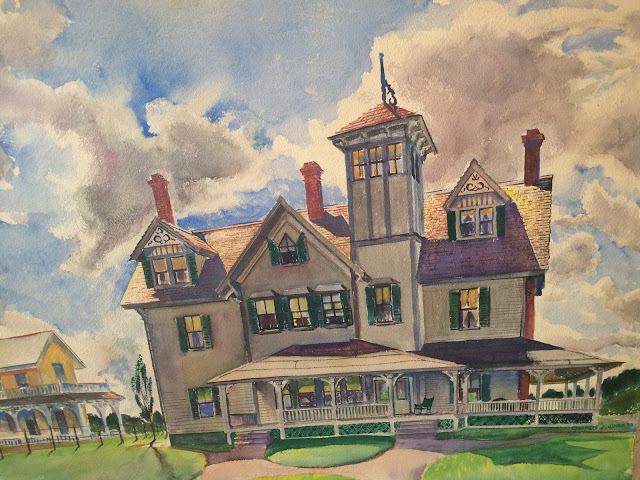While researching Francis Quirk, we have been able to find
out very little about him as a person. On-line profiles list him as a Roman Catholic. In a review of the work that was going up for auction in Maine recently
we were surprised to see several religious works. They may have been produced either for a
church or in pursuit of a larger commission.
This provides us with an incentive to spend more time exploring houses
of worship on the Maine seacoast. Who knows what we will find? (Spiritual enlightenment could be a side benefit.)
The first is a sketch for a triptych, altarpiece or mural. It
features a haloed Christ offering a blessing while flanked by two angels. On
either side are six haloed figures- perhaps the disciples?
 |
| Sketch of Jesus and the Apostles by Francis J. Quirk |
The next two are scenes from the Stations of the Cross.
 |
| Stations of the Cross 5th Station- Simon of Cyrene Helps Jesus to carry his cross. Painting by Francis J. Quirk |
The first painting depicts the fifth Station of the Cross in which a carpenter ,Simon of Cyrene helps Jesus to carry his cross. With the exception of the haloed Christ
figure the other figures are in contemporary dress and localized it with an
urban background including a golden dome. Notable features include a woman in
the classic 60’s protest anti-war pose and the hand in the foreground. Hands can be challenging to paint, so this
may have been an opportunity to engage in an exercise or to demonstrate his
skill. Could it have a special meaning?
 |
| Stations of the Cross 12th Station Jesus Dies on the Cross Painting by Francis J. Quirk |
The second is The 12th station in which Jesus Dies on the Cross. The scene has been localized to the Maine Coast with a lighthouse in the background and modernized with contemporary fashions including a businessman and a soldier. While it may have driven home a metaphor about his town and an outpost of the Roman Empire, it also may have raised a few eyebrows among more conservative parishioners at the time. For perspective, it was not uncommon at the time of the Viet Nam war for some people to vilify the military and sadly use insults such as the term “baby killer.” But, isn’t prodding thought part of what art is for?
The fourth is a pencil sketch for a work of Jesus meeting
with the Fishermen. He tells them to cast their nets on the opposite side of the boat. And they are rewarded with a
bountiful catch. In this sketch he has again localized it by putting the
fishermen in modern clothes and making the boats dories that were traditionally
used for cod fishing.
 |
| Sketch for painting of Christ and the Fisherman by Francis J. Quirk |
The sketch illustrates the thoughtful work Quirk put into
laying out his paintings and positioning the figures. Christ is center in a
position that foreshadows his eventual sacrificial death.
This image in the collection also struck our eye as a possible image of Jesus.However, we readily point out that Jesus probably did not use a pencil or pen.
 |
| Jesus? by Francis Quirk |
The final work is a charcoal sketch of people praying in
church. It includes people praying in the foreground and nuns in the rear.
 |
| Charcoal sketch by Francis J. Quirk |








































